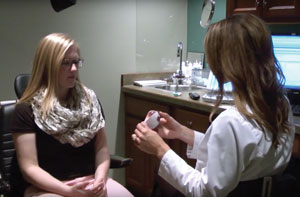In-office productivity, no matter what type or size of practice you have, is the basic tenet of practice success. An office that produces efficiently fosters a practice that can continue to grow and offer patients the best care and technology. Here are 10 management tips that helped grow my practice from zero to seven figures in just seven years:
 | |
| Being prepared for each patient before they sit in the exam chair can improve patient satisfaction—and your office’s productivity. |
1. Be Prepared for Your Patients
If you want to have successful patient interactions and the financial benefits that come with them, you and your staff must prepare. I set aside time before each patient day to go through my patient charts and write notes to myself and staff prior to that appointment. I delegate to my staff, via scheduling notes, all different types of preparation for that particular patient. For instance, was one of the patient’s family members in for an appointment recently? If so, we can acknowledge we remember that bit of information, making the initial greeting more personal. This can set the tone for the exam. (Make sure you have permission to share this information first. In my office, my HIPAA signature line states that the patient gives us permission to share necessary information with immediate family.) I delegate what testing I want done on the patient, including the mydriatic agents I need, photos, dry eye testing, inquiries into contact lens wear and habits, etc. It’s specific to that patient. Perhaps I noticed we were supposed to see this patient back for glaucoma testing, but the patient failed to schedule or show. I include notes for the staff to inquire about this. What if the patient has an active treatment plan for dry eye? I ask staff to attend to that patient’s routine to elicit why they may or may not be having success with that treatment regimen, even before I see them.
The same applies to optical recommendations. Is the patient’s chief complaint regarding poor near vision, yet they failed to comply with purchasing PAL’s last year? Delegate a technician to begin the discussion about this during pretesting. Or, perhaps you remember (or recorded) that last year they said they would most likely get new sunglasses this year. I will definitely note for my front desk staff to assist the patient in looking prior to the exam starting.
In knowing our patients, we show that we understand them and their vision needs. When we attend to our patients in the most specific and efficient way possible by being prepared, we see a surge in per patient revenues. We make every hour with our patients count, which can be a very productive strategy.1
2. Analyze Goals
Perhaps your first thought is, “What goals?!” You should set goals for your practice, be they small or large, and track and analyze your practice’s efforts to reach those goals on a regular basis.
After setting those goals, don’t be afraid to adjust them and find out why you are, or are not, reaching your goals. As an example, perhaps you have been tracking the results of your recent attempt to sell more contact lenses. You are surpassing your goal of selling annual supplies by three or four more each week. Adjust the goal to reflect your current strategy success, and aim for the next level. Because you and your staff are more effective than anticipated, you can adjust accordingly and discuss the methods that have led you to surpass your expectations. Conversely, if you are reaching lower numbers than expected after a few weeks or months of analysis, adjust the goal and meet with staff to find out why the goal wasn’t met. There may be a legitimate reason (fewer contact lens wearers in the last few weeks than average) that helps you realistically understand and amend your initial target.
We often get caught up in the day-to-day needs of patient care and practice administration. If we can spend some time actually analyzing what’s going on, we make our patient time that much more productive.2
 | |
| It’s more efficient for staff to spend 30 seconds scheduling next year’s appointment at check out rather than five minutes one week later doing the same thing, but having to look up all the data again. |
3. Manage the Schedule
Managing your patient schedule effectively is an often overlooked and underestimated component of successful practice management.3 Each patient who walks in the door is worth a certain dollar value every year (per patient average revenue).4 A pre-appointing system (preferably electronic) is important for maintaining a more regular interval between eye exams than relying on recall postcards, emails or phone calls to get a patient to the office. If you rely on patients scheduling themselves once you remind them they are due, they often come to your office every 18 months rather than every 12. With this method, they have a little more than three exams in a five-year time frame, instead of the expected five. That can lead to a loss of thousands of dollars for your practice over the course of time.
Another advantage of pre-appointing is that my staff found it’s far less time consuming to confirm or reschedule a pre-appointed patient than to have that patient schedule on their own. Patient-reliant scheduling results in more recall notices and calls, draining valuable staff time.
It takes my staff about 30 seconds to one minute to pre-appoint a patient at checkout for the same approximate day and time next year with our EMR system. The time spent by staff going back into the record to pre-appoint that patient a week or more later is about five minutes, once notes are reviewed and we prepare the scheduling information appropriately (tip #1). For just a week’s worth of patients missed in the pre-appointing process, the difference is about one staff hour of work vs. five hours. This adds up to thousands of dollars in inefficient use of staff time over the course of the year.
Of course, nothing will eliminate unpredictable events such as cancellations and last-minute no-shows. You can minimize the financial hit from these by using a waiting list of patients who want to see you ASAP. Maybe they already have an appointment scheduled, but would like to be notified if they can come in sooner. Or perhaps they want a prime time spot that’s booked weeks out in advance, and can come in at the last minute if a spot opens up. Doctor time is the most expensive staff time to have idle. Using this type of schedule management system and waiting list, I very rarely have an open spot in my schedule.
4. Streamline CL Fitting, Follow-Up and Ordering
One of the most productive ways to ensure your contact lens patients order their lenses through you and schedule regular exams is by putting a streamlined process in place.5 When a contact lens patient is in the office for their annual exam, we have pricing already prepared by staff, outlining the annual supply cost of the current brand of lenses they are wearing. If they are not changing lens modality or brand, the staff member offers the information to the patient at checkout with the assumption that they will purchase a year’s supply.
If, during the exam, you end up refitting the patient into a new brand, checkout pricing will now include the previous brand as well as the new brand. We include this information on a sheet of paper the patient can take home and scan it into that patient’s documents for reference. Staff will schedule a follow-up email/text/phone call or contact lens check visit with that patient in a week or two to finalize the new Rx and order. By implementing these steps, we are giving patients all the data they need, yet not losing them to follow-up. This causes less delay with ordering contact lenses, and doesn’t postpone next year’s appointment due to surplus supply.
5. Train Staff
Efficiencies don’t remain effective simply because they are in place. You must train and re-train on particular tasks, and often. It’s not enough to train someone once on a particular office task. If left to their own devices, most staff often begin to interpret their own version of how best to complete that task. While this may not be a bad thing in principle, the idea is consistency in the patient experience, and if one staff member differs greatly from another in how they perform a certain task—checking a patient in and out, for example—it can create confusion at best, and poor customer service at worst. Added to the possible patient-related issues are the financial implications that can ensue. If one staff member’s checkout process, as an example, results in a delay of payment or missed fees, this is financially detrimental to the practice. To avoid this, delegate a lead trainer in each area, review the processes and desired office workflow with them and make sure these policies are reviewed several times per year with appropriate staff.
6. Create a Procedural Manual
Have you ever had a staff member go on vacation or leave your practice altogether and panicked, realizing they were the only one who knew how to do something? If this has happened, you are in definite need of a procedural, or How-To, manual. This will outline how staff members should complete every single task in your office, no matter how mundane. At the very least, it saves you from having to figure something out on your own. Most importantly, though, it helps other staff members remember what to do in the absence of a key staff member, or if that staff member is preoccupied with patient concerns. Having a procedural manual allows your office to run smoothly regardless of the day’s staffing schedule, thus promoting the highest levels of productivity and efficiency.
7. Hold Regular Staff Meetings
Scheduling regular staff meetings is vital to ensuring staff is on the same page, policies are reviewed in a timely manner, office messages are delivered and training is carried through. We focus on a “why” question in my office at every meeting, which creates our core office culture.6 I present one or two real or likely-to-occur scenarios, and we as a team discuss how we can meet our “why” in that particular situation. This is our first agenda item for each meeting, before we move on to the business items, training, policies, etc. that are also integral to our meetings. We sometimes have vendors in the office to train on new products and technology. My office meeting usually takes two hours every Monday morning. We have a never-ending list of topics to discuss and it’s become critical to help integrate necessary changes while maintaining our office dynamics and workflow. I often let staff run the meeting, as they have excellent insight in the day-to-day needs of office life.7
8. Manage Patient Time in Office
Research has analyzed patient time spent in office and it’s correlation to sales in all areas, not just optical.8 It seems there are varying opinions, but the ideal time falls somewhere between 45 and 60 minutes. Anything longer than that, and sales generally seem to decline. After spending a few months analyzing my office’s patient flow, we noted a few things:
Entrance activities. This portion of the visit has a huge time variable. Established patients can move through this more quickly, but even a small change such as sharing new insurance benefits can alter that. Additionally, new patients who have not bothered to follow our advice in filling out forms before they arrive add anywhere from five to 15 minutes to their pre-appointment time. What we’ve done to countermand some of these slow-downs is to ensure we are not repeating questions among staff. For instance, asking patients the reason for their visit both at the front desk and during pretesting makes patients repeat what could be a lengthy explanation. Additionally, we’ve incorporated tablets for signing documents as well as protocol for pulling new patients back sooner into pre-tests if they are struggling to fill out forms.
Testing and exam. This time will vary most among doctors depending on your delegation preferences and your style of exam, but opportunities certainly exist for efficiencies. Something as simple as having the technician pull all pictures and networked tests forward so they are ready for you to show the patient can save one to two minutes per patient because you aren’t fumbling. If you see 20 to 30 patients per day, this can add up significantly. We are continually looking in this area for greater proficiency.
Doctor hand-off/optical. Our observations in this area focused on the dilation of patients’ eyes. Such an integral portion of the exam is critical for my practice’s standard of care, yet can really hinder a sale in optical due to blurry vision—which often leads to slower decisions or no end sale at all. We’ve attempted to improve this area’s efficiency by encouraging browsing before the exam, or offering the use of daily disposable contact lenses when browsing. (We do not do a full fitting, and the lenses are placed on eye by staff and removed by staff).
Paying attention to each step has pared down average entrance to optical time to around 40 minutes for most of our patients, which is our goal.
9. Share Information with Staff and Patients
You may be the primary information delivery vehicle in the office, but that doesn’t mean you can’t delegate pre-approved information sharing to your staff. Use educational clips within the office and your website, and give your staff the freedom to access and share them with patients.
 | |
| Keeping your optical space fresh will encourage patients to browse during their appointment and buy from you at the end. |
Today’s technology allows you to easily create your own clips to post on your website, showcase in the office or both. Tell the history of your practice, or feature what’s new in the practice. Doing so will help patients feel they are an active part of the success of your practice, which can foster patient loyalty. A low-tech option would be to organize informational binders for the reception area. I find our patients looking through our binders more than I ever thought they would. It’s a great way to focus on the services and products your practice offers, and you can even offer promotions within the binders for those who are savvy researchers.
10. Mix Up The Merchandise
Have your displays of optical goods, contact lenses and other ophthalmic products looked the same for years? Or for even just one year? Successful merchandisers realize the need to reorganize, re-display and mix it up to keep products looking fresh and new. You can improve your office productivity by implementing some great merchandising tactics. If you can help sell something simply by how it’s displayed or presented, that display becomes the most effective “employee” in the office.
That “employee” needs to be tended to, and diversification is important. Like you sometimes, patients will often look at a typical “wall of frames” and just feel “blah.” Great merchandisers diversify their displays to showcase layers, textures and highlight various products. Essentially, they want to spark some interest. Often, you can learn from your own favorite stores how to effectively merchandise. Pay attention to what grabs your attention. Make it interesting, and your patients will respond. And then change it up.
As with any new practice management strategies, not only you, but also your staff, have to be onboard with these new ideas. I would suggest rolling out ideas at an office meeting, and know you need to be honest about what’s expected for all involved when you implement any change.8 Time spent improving productivity is perhaps the hardest first step to take, but is wellworth the outcome.
Dr. Wesley is an active member of the American Optometric Association and a fellow of the American Academy of Optometry. She was awarded the 2013 Early Professional Achievement Award from The Ohio State University College of Optometry and was Minnesota’s 2011 Young Optometrist of the Year. Her Vision Source practice serves primary care, contact lens and pediatric patients.
1. Gerber G. Does extra work equal extra income? Rev of Cornea and Contact Lens. 2013;150(2):34.2. Trenchard B. 70% of Time Could Be Used Better - How the Best CEOs Get the Most Out of Every Day. http://firstround.com/review/70-of-Time-Could-Be-Used-Better-How-the-Best-CEOs-Get-the-Most-Out-of-Every-Day/.
3. Kattouf RS. An optometrist’s to-do list for 2012. Optometric Management. 2012;47:24.
4. MBA Key Practice Metrics: Assessing Optometric Practice Performance. 2014.
5. ABB Concise Practice Pearls. https://www.abbconcise.com.
6. Sinek S. Start With Why: How Great Leaders Inspire Everyone to Take Action. New York, NY: Penguin Publishing Group; 2009.
7. Spittle B. Let your staff run your staff meetings. Rev of Opt. 2010;146(11):31.
8. Acuvue. Transform your practice with ODLean. www.acuvueprofessional.com/odlean.
9. Gerber G. Six steps to foster staff support. Rev of Cornea and Contact Lens. 2011;147(4):11.

